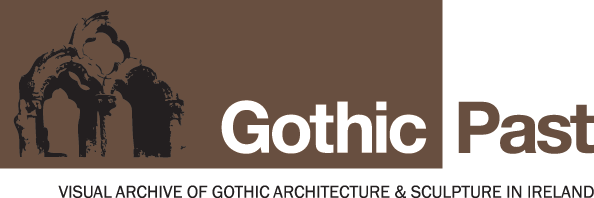Browse Items (125 total)
Sort by Title [A-Z] | [Z-A]
Athenry Castle, exterior east wall, door, jamb and arch
Jamb and arch of pointed door that might be called Transitional or Early English in style. The mouldings perhaps too large and simple to be Early English. Moulding comprises: angle roll flanked at either side by quarter roll, and to front face by hollow chamfer.
Ross Errilly Franciscan Friary, south chancel wall, piscina, base
Base of octagonal piscina shaft. From top down moulding comprises: chamfered fillet as necking, bell, roll, bell, plinth.
Kilconnell Franciscan Friary, north chancel wall, tomb niche, mullion
Mullion of tracery in canopied tomb niche. Moulding comprises: central fillet flanked at either side by hollow, quadrant, right-angled rebate, quadrant, hollow.
Clontuskert Augustinian Priory, rood screen, capital
Capital of rood screen, from top down moulding comprises: scroll, roll, angle-fillet, scroll with upper and lower fillets, bell with keel, necking-scroll. This capital is very similar to those from the cloister at Holycross and the group related to it - particularly the use of the scroll, roll and angle-fillet in the upper element and the keel in…
Clontuskert Augustinian Priory, rood screen, arch
Arches of rood screen, moulding from soffit comprises: quadrant, fillet, quarter-hollow, fillet, right-angled rebate, fillet, ogee, right-angled rebate, ogee, fillet, hollow chamfer, quadrant, ogee, fillet. Extensive use of ogees here, a late Gothic moulding rarely found in Ireland. When found it is often in association with very high quality work.
Clontuskert Augustinian Priory, cloister, base
Base from reconstructed cloister, moulding from top down comprises: roll, bell, drooping keel, bell running into plinth.
Clontuskert Augustinian Priory, cloister, base
Base of reconstructed cloister, from top down moulding comprises: roll, bell, roll, roll, bell, plinth with quirks. The middle element here looks rather like the double rolls of an English Perpendicular base.
Clontuskert Augustinian Priory, cloister, capital
Capital from reconstructed cloister, moulding from top down comprises: abacus, quadrant, angle-fillet, scroll, fillet, bell, necking scroll.
Clontuskert Augustinian Priory, cloister, capital
Capital from reconstructed cloister, moulding from top down comprises: abacus, roll, roll, angle-fillet, roll-and-fillet, fillet, bell, necking roll-and-fillet.
Claregalway Franciscan Friary, north chancel wall, tomb niche, jamb
Jamb of tomb niche, larger rolls topped by capitals and bases. Moulding from inner face comprises: large roll, hollow, roll, hollow, roll, hollow, large roll, hollow, roll, hollow, roll - this roll runs into the flat wall surface. Few of these western tomb niches have separate straight jambs with shafts provided with capitals and bases - this…
Claregalway Franciscan Friary, north chancel wall, tomb niche, base
Tomb niche, base of jamb. Moulding from top down comprises: roll, roll, chamfer, plinth.
Athenry Dominican Priory, south nave wall, niche, base
Base of eastern niche in south nave wall, from top down moulding comprises: roll, bell, roll and fillet, roll, plinth.
Athenry Dominican Priory, north wall of north transept, wall arcade, capital
Three unit capital, moulding from abacus down comprises: chamfred abacus, quadrant, hollow, quadrant, fillet, bell, necking roll.
Timoleague Franciscan Friary, north nave wall, tomb niche, capital frieze
Capital frieze running along jamb of tomb niche. Unusual moulding from the top down comprises quarter roll, fillet, bell, roll, roll.
Timoleague Franciscan Friary, north choir wall, tomb niche, jamb and arch
Jamb and arch moulding of tomb niche, from intrados moulding comprises chamfer, quadrant, hollow chamfer, broken quadrant.
Timoleague Franciscan Friary, north choir wall, tomb niche, tracery bar
Tracery bar of tomb niche. Moulding comprises: centre frontal roll flanked at either side by hollow chamfer, quadrant. They rear of the tracery bar is rectangular.
St. Sepulchre's Archiepiscopal Palace, Hugh Inge's Door, jamb and arch
Door jamb and arch moulding comprising: hollow chamfer, quadrant. The door was inserted by Archbishop Hugh Inge in 1523 and restored in the eighteenth century. Fragments of window found during recent excavations have the same scale moulding and are likely to associated with the door. The door is unusual in that it has a three centred head.
Dunsoghly Castle Chapel, door jamb, arch and hood
Door jamb, arch and hood of the detatched castle chapel. Jamb and arch moulding from intrados comprise: hollow chamfer, right-angled rebate, quadrant. The hood, which is placed at some distance from the jamb, comprises from outside in: frontal fillet, hollow chamfer, right-angled rebate, hollow chamfer.
St. Margaret's Church, Finglas, door jamb, arch and hood
Jamb arch and hood moulding. From intrados, jamb moulding comprises:quadrant, hollow chamfer, quadrant. The splayed jamb and hood are separated by a small hollow. The hood, from outside in, comprises: angle-fillet, angle-fillet, angle-fillet, angle-fillet.
St. Mary's church, Killyleigh, east window, hood
Square label of east window. Moulding from exteral to internal face comprises: frontal fillet, roll, roll.




















